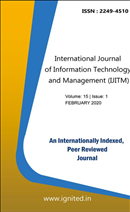A Comparative Study of Employee Job Satisfaction in the Private and Public Sector Banks
Main Article Content
Authors
Abstract
As the biggest independent country, India is also a global economic powerhouse. It is impossiblefor India to have a robust economy if its financial sector is weak. It has a significant impact on our country.Some of the country's poorest residents lack access to official banking services. Indian banking has madea number of noteworthy contributions during the past three decades. The purpose of this study is to look atthe characteristics that influence job satisfaction among operational level personnel in both of the banksunder consideration. It also tries to figure out how the various components interact. A questionnaire with26 questions on a likert scale was created for 400 operational level personnel. The surveys weredistributed to 200 workers from each bank. The data was gathered with a lot of work.
Downloads
Download data is not yet available.
Article Details
Section
Articles
References
- Azash, S Md. ET..Al. (2011), The Motivational Factors and Job Satisfaction: A Study on Selected Public and Private Sector Bank Employees in Kadapa District, Andhra Pradesh, Journal of Arts, Science & Commerce, Vol.2, Issue 4, Pp: 161- 168.
- Sowmya, K. R. &Panchanathan, N. (2011), Factors influencing job satisfaction of banking sector employees in Chennai, India, Journal of law and conflict Resolution, Vol.3(5), Pp: 76-79.
- Beder, Hind A.M. (2013), Job Satisfaction among Bank Employees in Eastern Libya, American International Journal of Social Science, Vol.2, No. 1, Pp: 30- 44.
- Chahal, Aartiet. Al. (2013), Job Satisfaction among Bank Employees: An Analysis of the Contributing Variables Towards Job Satisfaction, International Journal of Scientific & Technology Research, Vol. 2, Issue 8, ISSN: 2277-8616.
- Javed, Afiz Ali ET. Al. (2014), Leadership Styles and Employees’ Job Satisfaction: A Case from the Private Banking Sector of Pakistan, Journal of Asian Business Strategy, Vol. 4(3), Pp: 41-50.
- Prachi B Mehta and Richu M Juneja (2017) “A comparative study of employees job satisfaction in selected public and private sector banks”, International Journal of Applied Research 2017; 3(1): 620-625
- Sailaja R, Naik C. Job Satisfaction Among Employees of Select Public and Private Banks in Rayalaseema Region, A.P. International Journal of Research in Management. 2016; 2(6)
- Khan AS, Iqbal N, Khan M, Haider N. Job Satisfaction and Security among Bank Employees and their performance: Study of Public and Private Sectors Banks of Southern Punjab Pakistan. Journal of Business and Management Research. 2015; 8:217-219.
- Khana, SaeedAAmiret. al. (2015), Job Satisfaction and Security among Bank Employees and their Performance: Study of Public and Private Sectors Banks of Southern Punjab Pakistan, Journal of Business and Management Research, Vol.8, Pp: 217-219.
- Sattar, Saba& Ali, Nimra (2014), Level of Job Satisfaction among employees of Banking Industries at Bahawalpur, IISTE, Vol.4, No.3, Pp: 1-6.
- Malpani, Sangeeta & Varshney, M.G. (2014), Job Satisfaction of Private Sector Bank Employees, Indian Journal of Applied Research, Volume: 4, Issue: 8, ISSN- 2249-555X, Pp: 375-379.
- Shukla, Smita & Malusase, Rakesh, Risk Analysis of Selected Public and Private Sector Banks Operating in India, IOSR Journal of Economics and Finance, ISSN: 2321-5933, Pp: 48-59.
- Khuong, Ngoc Mai &Tien, Diem Bui (2013), Factors influencing employee loyalty Directly and Indirectly through Job Satisfaction-A study of Banking Sector in Ho Chi Minh City, International Journal of Current Research and Academic Review, Vol.1 (4), Pp: 81-95.
- Khan, Anum (2013), Is Job Satisfaction of Islamic Banks Operational Staff determined Through Organizational climate, Occupational Stress, Age and Gender, Journal of Business Studies Quarterly, Vol.4 (3), Pp: 13-26.
- Jitender Kumar Singh and Dr. Mini Jain (2013), Leadership Styles and Employees’ Job Satisfaction: A Case from the Private Banking Sector of Pakistan, Journal of Asian Business Strategy, Vol. 4(3), p: 41-50.

